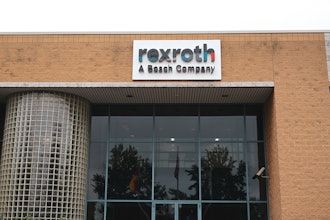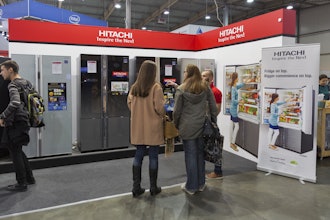White paper
Collaboration as a
Key to Success in Retail
www.lascom.com - San Diego office +1 858 452 1300 - Paris office +33 1 69 35 12 20 - ©All right reserved Lascom 2014
Page 2 sur 28
Content
Executive summary .................................................................................................................................................. 3
Reasons to improve collaboration with suppliers ........................................................................................ 5
Supplier Relationship Management (SRM) ..................................................................................................... 7
A collaborative “project room” ............................................................................................................................ 9
From complex and slow business processes… ........................................................................................ 10
…to a dynamic and organized structure ................................................................................................... 11
Better structure and information management ................................................................................. 11
The repository ................................................................................................................................................. 11
SRM business processes efficiency .................................................................................................................. 16
Request For Proposal management ........................................................................................................... 16
RFP efficiency .................................................................................................................................................. 18
Collaborative specification ............................................................................................................................. 19
Launch wrap-up .................................................................................................................................................. 20
Artwork collaboration .................................................................................................................................. 20
Merchandising & Sales Promotion ............................................................................................................. 20
Product information transfer to supply chain ......................................................................................... 22
Post launch business processes ........................................................................................................................ 23
Sanitary alerts ...................................................................................................................................................... 23
Audits...................................................................................................................................................................... 23
Change Management ....................................................................................................................................... 24
Consumer care .................................................................................................................................................... 24
A Global Solution .................................................................................................................................................... 25
Access anywhere ................................................................................................................................................ 25
Multi-langual ....................................................................................................................................................... 25
Multi-cultural ....................................................................................................................................................... 25
Multi-regulatory ................................................................................................................................................. 25
Conclusion ................................................................................................................................................................. 26
References ................................................................................................................................................................. 27
Lascom ................................................................................................................................................................... 27
Lascom CPG solution ................................................................................................................................... 27
www.lascom.com - San Diego office +1 858 452 1300 - Paris office +33 1 69 35 12 20 - ©All right reserved Lascom 2014
Page 3 sur 28
Executive summary
As consumers grow more demanding, retailers need to ensure products are available at the
right time, through the right channel and at the right price. While it seems collaboration
between retailers and suppliers has existed forever, it has become more essential for success.
While today’s manufacturers and retailers are each facing significant but unique challenges,
there is common goals that drives collaboration - higher sales, increased profitability, and
stronger business growth.
Indeed, an ECR-McKinsey survey shows that an effective collaboration between retailers and
suppliers results in a cost reduction of 5.4%. and a 4.4% decrease in out-of-stocks. It also
increases revenues by 3.7% more than the average company.
Even if many industries have already fully understood the opportunity of an optimized
collaboration, Retail is still in the early stages due to both traditional past behavior and a fear
of sharing sensitive information. Indeed, the retailer-supplier relationship has long struggled
with distrust from both parties acting in self-interest. Retailers and suppliers can overcome
this challenge by better sharing information and truly collaborating to exceed customer
expectations.
At its most advanced level, they are all part of a shared system, jointly pursuing opportunities
to improve margins and growth across the entire value chain to benefit the end-consumer
through:
NPD: Collaboration eases new product development from the marketing brief (retail)
to production (supplier) all along R&D and quality processes.
Request for proposal and tender selection: Through an effective bidding process,
retailers are able to choose best suppliers for product.
Time to market improvement: It no longer simply consists of a new product a
retailer is offering but also to the retailers’ ability to adapt and adjust to the changing
marketing world around them. Suppliers are fully part of this new process.
Range and product optimization: To optimize existing formula with less costly
alternative or trendy ingredients, retailers have to involve suppliers in their portfolio
categorization.
www.lascom.com - San Diego office +1 858 452 1300 - Paris office +33 1 69 35 12 20 - ©All right reserved Lascom 2014
Page 4 sur 28
New market access: Retailers must consider multi-language and localization (multi-
regulatory) issues while setting up on a new marketplace. Collaborate with suppliers
at this stage is essential to enter a new place in optimal condition.
This document scopes the essential of an efficient supplier-retailer relationship, its
advantages and how to manage it to improve growth, competivity and boost innovation.
www.lascom.com - San Diego office +1 858 452 1300 - Paris office +33 1 69 35 12 20 - ©All right reserved Lascom 2014
Page 5 sur 28
Reasons to improve
collaboration with suppliers
To overcome today’s challenges, smart retailers are taking a more focused look at
collaborating with their supplier, seeing them as partners. A successful retailer-supplier
collaboration can help smooth pressures along the product lifecycle. A strong partnership
brings products to market faster, reduce costs, increase sales and market share, while
maximizing ROI for both parties.
Main reasons to improve collaboration are:
Revenue enhancement:
Working jointly to harness complementary skills is key to better anticipate and react
to commodities price volatility.
It becomes a real challenge for food companies and retailers to ensure sustainable
margins. Crops, dairy products, oils, chemicals, etc. have high influence on companies’
bottom line results. It is crucial to collaboratively work on quick adjustments to
maintain high margins on both sides.
Cost reduction:
Collaboration reduces administrative tasks and improves communication. It also
facilitate specifications sharing process through web collaboration both for initial
specifications -used to create a new product from scratch- and updated specifications
- it assumes an effective change management and a robust impact analysis.
Market shares :
Through innovation performances, collaboration also grows market shares and
accelerates innovation providing:
More disruptive ideas
Better decision making process
Greater success rates
Fewer errors
Reduced risks
Innovation performances also includes time to market rush. Being successful with time
to market is heavily dependent on a highly effective planning process and error-free
execution in both organizations.
www.lascom.com - San Diego office +1 858 452 1300 - Paris office +33 1 69 35 12 20 - ©All right reserved Lascom 2014
Page 6 sur 28
Process improvement:
A wide range of supplier-related processes can be improved by more intense retailer–
supplier relationships. Many retailers are eager for more quality and traceability and ask their
suppliers to comply with up-to-date food standards. Processes include sourcing, product
specifications, quality certifications, recalls, promotion planning, execution, and all the supply
chain processes.
Supplier Relationship
Management (SRM)
Private label products have existed throughout the history of retailing. In Europe, retailers
such as Boots, Marks & Spenser, and Tesco have sold private label store brands for
generations. During the recession in the early 1980s, generic ‘no name' brands were
introduced in the U.S. as low-cost alternatives to national brands. During the late 1980s,
private label growth was phenomenal, with grocery unit shares reaching over 15%. By that
time, private labels products were following the rule “doing it on the cheap.” They were
copycats of national brand products.
But, private label quality has improved dramatically since the days of generic products.
Several recent consumer reports studies have claimed that the quality gap between national
brands and private label products has been reduced or eliminated. Accordingly, consumer
perception has improved substantially, creating a highly positive attitude towards private
label. In a recent survey by The Nielsen Company, 63% of consumers considered private label
brands to be of equal quality to national brands, and 72% of the respondents felt that private
label products were good alternatives to name brands.
The traditional approach to developing low-cost, generic alternatives to national brands,
targeting price-sensitive, brand-agnostic shoppers, is giving way to a much more strategic
role for private label, as part of more thoughtful shopper segmentation, category
management and assortment planning strategies.
Brand manufacturers have historically been able to compete effectively by creating disruptive
products and package designs. Nowadays, retailers’ contribution to NPD is more important
than ever. Retailers are pushing continuous innovative products and their role shift to be fully
part of – and often drive - product innovation.
www.lascom.com - San Diego office +1 858 452 1300 - Paris office +33 1 69 35 12 20 - ©All right reserved Lascom 2014
Page 8 sur 28
Things have changed and ratio of power is more balanced, for the best of both parties. One
way relationship has transformed to collaboration, installing trust for retailers and suppliers in
a competitive market.
The different stages of the private label history
One way
relationship
“Me-too” private
label
- price- based
- highest margin
possible
- low quality product
Cooperation
Price / performance
ratio
- maximize consumer
value through
information sharing
- finer analysis on
operational costs
- higher concern in
quality
Partnership
Differentiation
- shared sales goals
- maximize supplier
value
- exhaustive Product
Lifecycle Management
Collaboration
Innovative products
- suppliers and
retailers are both
integrated in
competitiveness and
success
- common strategic
goals
- category
management
strategies
www.lascom.com -San Diego office (1) 858 452 1300 - Paris office (33) 1 69 35 12 20 - ©All right reserved Lascom 2014
Page 9 sur 28
A collaborative “project room”
During WW2, operations were managed from a “war room” encompassing skills and
technology required to optimize operations. Implementing a collaborative tool/software to
better manage their product portfolio, improve innovation processes, gain in productivity
and benefit from their suppliers knowledge is a common concern for many retailers. Product
management plays an integral role in the overall control and lifecycle of a product.
The great breadth of retail also requires the ability to discern what is key to prioritize in terms
of projects. This ability to streamline the management of any project is the hallmark to
benefit from a quicker, more-efficient, and less-expensive project lifecycle.
To better manage products and projects in retail, smooth and effective collaboration is
crucial. Collaboration means develop, launch and monitor new and existing products through
a coherent and structured process where every participant involved is able to find the right
information whenever needed.
Most of the issues related to poor efficiency are redundant tasks and multiple keying that
slows the process and contribute to higher complexity.
Processes are optimized through 2 pillars; first, structured data build a reliable repository,
performing as a “single version of the truth”; second, well-organized stages such as RFP /
bidding process, specifications consistency, control and effective change management
considerably favor satisfactory product launch.
www.lascom.com -San Diego office (1) 858 452 1300 - Paris office (33) 1 69 35 12 20 - ©All right reserved Lascom 2014
Page 10 sur 28
From complex and slow business processes…
Many retailers do not benefit from a centralized platform gathering all data and
documentation about products. It results in several issues:
Large volume of paperwork and administrative tasks
Each department uses siloed information while developing new products
Data are not sharp enough to meet local/global regulation’s requirements
Data are duplicated in many places throughout the lifecycle
Repetitive processes are manual and error-prone
Time to market is slow due to ineffective NPD processes
Collaboration with suppliers is poor
A complex and barely efficient vision - Participants have difficulties to access the right information at the right moment
Risks due to a complex organization and poor collaboration lead to costly management.
Obsolete information and non-compliance can result in a large volume of recalls.
www.lascom.com -San Diego office (1) 858 452 1300 - Paris office (33) 1 69 35 12 20 - ©All right reserved Lascom 2014
Page 11 sur 28
…to a dynamic and organized structure
To cope with unstructured discrepancies, sharing a common platform with suppliers and
benefiting from a “single version of the truth” is key.
Better structure and information management
As product and specification management is tedious and risky (obsolete version,
inappropriate dispatching, etc.), retailers are looking for a single centralized repository to
gather structured data and documents all along the product lifecycle.
The repository
Retailers are concerned with an increasing volume of data due to range expansion and a
harsher regulatory compliance.
The solution is to benefit from a robust platform performing as a unique repository to offer a
“single version of the truth” to all participants. Lascom CPG facilitates collaboration through
clean document versioning and always accurate product data. Participants benefit from a
customized access regarding their business roles and responsibilities – for instance suppliers
can only access raw material they provide if defined as if.
For most organizations, the product information repository stores a great deal of data,
document, and any other type of information both from internal teams and extended
business. Therefore, in order for company’s teams to effectively locate specific information
about product or specifications it is equally important to retrieve them through a variety of
search features.
A single core repository makes product information management easier and specification
management more efficient. Lascom repository also incorporates additional collaboration
features such as creation wizard, mark-ups and reviews, alerts, electronic signatures, etc.
www.lascom.com – U.S. office +1 858 452 1300 – Europe office +33 1 69 35 12 20 - ©All right reserved Lascom 2014
Page 12 sur 28
The repository organizes data such as:
Product/Project
information
Description
NEEDS
These are raw material/packaging requirements and marketing briefs
REQUEST FOR PROPOSAL
Match and screening of multiple suppliers proposals and RFP
requirements
ARTICLES
Articles are products and all their components: raw materials, packaging
items, artworks, packing items, etc.
NUTRIENTS
Nutritional facts calculation are made from this library and used in the
formulation tool
INGREDIENTS
These are references used to create ingredients lists - including
preservatives- and package design.
& MORE
Claims (organic, kosher, suitable for vegans, etc.),
allergens, geographical origins, etc.
Quality Description
QUALITY CONTROLS
Quality control plan, batches, samples, results, certificate
ANALYSES
Allow to store all analyses results made upon raw material/supplier pairs
with criteria attached.
AUDITS
Allow to monitor all criteriae matching IFC, BRC, ISO etc. requirements
upon product/supplier.
COMPLAINTS
Allow to store all consumers’ complaints.
Supplier information Description
PARTNERS
These are all information about partners. Partners could be suppliers,
laboratories, customers, etc.
CONTACTS
These are all contacts partners are in touch with.
www.lascom.com – U.S. office +1 858 452 1300 – Europe office +33 1 69 35 12 20 - ©All right reserved Lascom 2014
Page 13 sur 28
Documents Description
FILES
Many objects types can be stored in files. These files can be associated by themes.
OTHER DOCUMENTS
These are internal documents such as technical datasheets, reports, sales
speeches, user instruction, etc. and external documents such as proofs for
packaging prints, etc. They can involve direct change or be impacted by
indirect changes throughout product lifecycle.
EDMS (electronic document management system) will ensure a clean document versioning
with role based access.
Handling product specifications with document only cannot be achieved anymore. An
effective way to deal with those specifications is not only to consider documents but also
data themselves.
From restricted data…
Re-keying, re-approval of same documentation, waste of time, etc. are some of the
drawbacks participants working in silos face.
Collaboration supposes as well the intent to collaborate. In some cases, intellectual property
and monopoly concerns are such that it is extremely tricky to collaborate properly. In these
situations, individuals may encounter collaboration hurdles.
…to collaborative data
Implications on sharing a “single version of the truth” are:
Sharing libraries of specification item
Sharing their translation
Assuming that changing the same content with multiple usages will require to
manage all the impacts
Retailers taking their suppliers’ knowledge into account and involving them as experts in their
activity show better results. There is no longer a sole agent owning knowledge about
products, goals, technical needs, strategy etc. The advantage of sharing a common platform
is also to be aware of new raw materials and/or products through suppliers input and use
them as opportunities.
www.lascom.com – U.S. office +1 858 452 1300 – Europe office +33 1 69 35 12 20 - ©All right reserved Lascom 2014
Page 14 sur 28
Both retailers and suppliers have a common goal: the customer satisfaction.
To achieve that goal, quantitative data sharing shall be set up and acknowledge business
practices shall be organized.
Restrictive data Collaborative data
Information scattering
Out-of-date documentation
Waste of time
Re-keying of data
Multiple platforms and repositories
with inconsistent information
Inefficient tracking process and
recording
Inaccurate analyses
Optimize retailers’ production cycle
Increase data workflow efficiency between
participants
Track and version modifications
Automate processes
Rely on updated information
Be aware of any change or any proposal
input
Monitor activity to improve innovation
process
Collaboration has to be efficiently secured. Access rights can be customized to improve
collaboration by sharing needed information while remaining safe for both parts.
A second level of efficiency in collaborative partnership deals with specialization of the
business processes:
Throughout segments
Food and Beverage
Appliances
Textile
Personal Care, etc.
Throughout departments
Marketing
Sales
Procurement
Quality
Logistic
Finance, etc.
www.lascom.com – U.S. office +1 858 452 1300 – Europe office +33 1 69 35 12 20 - ©All right reserved Lascom 2014
Page 15 sur 28
Through business roles:
Suppliers
Partners
Laboratories
Sub-contractors, etc.
For all the participants such a structured information will:
Be reusable
Ease decision process
Facilitate business monitoring
Reinforce accountability and consistency
To enhance the quality of the partnership, sharing a common understanding of the product
data is beneficial for both parties but a second leverage opportunity is to act on the business
flows efficiency as well.
www.lascom.com – U.S. office +1 858 452 1300 – Europe office +33 1 69 35 12 20 - ©All right reserved Lascom 2014
Page 16 sur 28
SRM business processes
efficiency
Scorecarding & Gantt chart
To streamline SRM business processes project screening is essential. Therefore, stage-gates
have to be timely managed with Gantt charts while scorecarding will support priorization.
Lascom CPG provides tools to structure tasks and dispatch them to the various stakeholders.
Top management expectations are to monitor activities to spot potential issues and drill
down into details to fix the problem.
Request For Proposal management
As seen previously, an RFP followed by a bidding process involves a lot of data such as
marketing brief, pre-specifications, sample reviews, analyses, suppliers’ certificates, etc. As
data are divided in elementary parts, it is easier to dispatch, generate or edit any kind of
information within the workflows. An organized structure facilitates business reviews while
remaining coordinated through workflow. They are also useful to capture metrics
contributing to a proper RFP monitoring. Eventually, business process management supports
massive parallel tasking to cope with multiple suppliers’ reactivity.
Example for an RFP process
www.lascom.com – U.S. office +1 858 452 1300 – Europe office +33 1 69 35 12 20 - ©All right reserved Lascom 2014
Page 17 sur 28
Requests for Proposal management are different from a company to another. But global
process could be sum up through main stages as followed:
• RFP templates creation
• Definition of a workflow (stages, tasks etc.)
• Brief approval
Product scheme
• Selection of a RFP template and fill up
• Selection of a list of suppliers to send to
• Answers gathering and classication
Call for bids
• Choice assistance in the best fit
• Approval of 1 or 2 suppliers
• Sample : specification, technical datasheet etc.
• Collaboration through the platform
Supplier shortlist
• Specification approval
• Supplier approval
• Product addition in the repository
Approval and manufacturing
• Signature with the selected supplier
• Documentation management
Contract management
R
F
P
m
a
n
a
g
e
m
e
n
t
p
o
rt
a
l
S
p
e
ci
fi
ca
ti
o
n
s
m
a
n
a
g
e
m
e
n
t
- RFP process automation
- Tracked and managed workflows
- Improved collaboration
- Suppliers input
- Workflows with suppliers
automation
- Alerts for return proposal
regarding priority
- Attached documents generation
automation
- Comments attachment
www.lascom.com – U.S. office +1 858 452 1300 – Europe office +33 1 69 35 12 20 - ©All right reserved Lascom 2014
Page 18 sur 28
RFP efficiency
Productivity in the innovation and quotation process will be highly increased dispatching
automatically the technical data requirements to the various suppliers involved.
But the business process has to be flexible enough to promote suppliers pro-activity as well.
Various technologies to support RFP are crucial.
A portal technology
Optimizing RFP process and collaboration with suppliers often means benefiting from a
portal with dedicated access to securely input information about proposals, quotation or
product specifications. Tight seal front office to avoid information leaks from a supplier to
another is key. A back office repository is also required for retailers to compare suppliers
involved in the process.
Digital RFP exchange
RFP are sent to many suppliers. Each supplier can propose many products. Each product /
supplier pair has its own documentation, specification dataset, certificates, etc.
To avoid the pain to compare manually different bids, retailers require tools to:
Screen and comment information easily
Manage loopbacks with suppliers with a full audit trail
Compare ( submission 1 VS submission 2 ; supplier bid 1 VS supplier bid 2)
Approve individually business topics to unlock the overall approval. Lascom offers
to check each chapter. Everyone in charge of a chapter/task is able to approve it
separately considering skills needed. A final approval with electonic signature
secures the entire process.
www.lascom.com – U.S. office +1 858 452 1300 – Europe office +33 1 69 35 12 20 - ©All right reserved Lascom 2014
Page 19 sur 28
Suppliers certificate assessment
Using the collaborative portal suppliers will upload various document required to testify their
quality policies (ISO, BRC, organic, kosher, certificates, etc.).
Electronic signature
Electronic signature lawful status is key in accountability. Partners will approve product
quality policy through validation processes.
Electronic signature will ensure data integrity and partners commitment.
Collaborative specification
RFP goal is to select a supplier based on price and pre-specifications. Once the RFP is
granted, technical specifications must be sharpened and approved both by the retailer and its
choosen supplier.
To be more efficient, departments must be able to work on many tasks at the same time
without bothering or slowing down each other. By managing electronic specifications with
chapters, businesses gain in effectiveness. GS1 developed a global standard, still in
implementation, to syndicate practices.
On the same frame, in Australia and New Zealand, the Product Information Form (PIF) is an
operational standard. Indeed, thanks to a unique template shared by all the community
business relations are faster between partners. It could someday become a new regulation
out of Australia to improve product information and traceability. The PIF was a tool co-
developed both by retailers and manufacturers to captured specification data with a better
auditability to check regulatory requirements and product consistency.
PIF avoids the potential confusion of having different forms for different sets of regulatory
requirements.
To ensure specification consistency, business process management is key as well. Participants
have to work at the same time on different tasks. Specification contents are consolidated and
approved without slowing down others.
Raw material, ingredients and product information must remain attached to a finished
product at any stage of the lifecycle and being accessible by anyone with the right to edit or
update the products.
As seen, Lascom ensures that product specifications are based on a “single version of the
truth” characteristics library; as collaborative specification is an iterative process, Lascom CPG
provides a full traceability of the various changes and submissions.
www.lascom.com – U.S. office +1 858 452 1300 – Europe office +33 1 69 35 12 20 - ©All right reserved Lascom 2014
Page 20 sur 28
Launch wrap-up
Artwork collaboration
Product specification involves packaging specification too. Since packaging and artwork
engage many functional disciplines within the company – while simultaneously engaging a
large network of external partners – packaging and artwork management is a definitive
collaboration bottleneck.
Yet they face critical barriers to tackle in order to achieve effective packaging and artwork
management, including:
Lack of certainty and time about the finished product final definition. Packaging and
artwork are often on the critical path of the launching process.
Difficulties for designers, developers and production teams to collaborate efficiently.
Indeed, business concerns are largely heterogeneous and iterations are short and plenty.
Paper-based artwork review. For most companies, artwork review and approval are a
lengthy process in which hard-copy drafts and proofs are circulating to internal groups
and external agencies for review and comment.
Defects and errors in pack copy and artwork are primary reasons for product recalls, costing
companies millions of dollars in lost revenue.
Lascom collaborative solution makes it possible to conduct virtual packaging reviews. Digital
mark-ups can be directly added on the document. Reviewers are then able to approve or
reject comments regarding their role.
Electronic sign-off, good to print and a full version history ensure transparency and
accountability throughout the process. As a result, participants can be sure that a complete
and accurate print file is released to production.
Merchandising & Sales Promotion
Approximately 60% of all chocolate candy is sold on promotion. Even for such stable items as
rice and peanut butter, approximately 30% of volume is sold on promotion. For seasonal
items, such as stuffing mixes, 80% fourth calendar quarter sales are sold on promotion.
Promotional spending now consumes 54% of retail marketing budgets and represents an
average of 17.3% of gross sales in the U.S.
The companies willing to fully leverage in-store opportunities will need to focus on
merchandising and POS material. Product combinations and pricing strategies drive single
category and cross-category sales.
www.lascom.com – U.S. office +1 858 452 1300 – Europe office +33 1 69 35 12 20 - ©All right reserved Lascom 2014
Page 21 sur 28
Getting to market with promotional packaging and displays is challenging due to:
The multiplicity of actors involved – including marketing, sales, finance, category
management, communication agencies, legal, logistics and department supervisors.
The assortment of references for a promotion. Retailers have to carefully consider
their needs and bottom lines for a specific holiday – e.g. Mothers Day - while
suppliers offer operations associated with volume.
The assortment of pricing and promotional strategies – loyalty points, discounts, “buy
one get one free”, etc. – Whole categories are impacted and retailers observe whole
store effects. Some promotions can cannibalize sales or drive incremental traffic in
store. Costs forecasts are then very complex to handle.
The slow “stage gate” process composed by many tasks and organized through a
schedule long time before the actual promotion.
Best-in-class retailers are modifying their in-store promotional processes in collaboration
with manufacturers to eliminate bottlenecks, enhance efficacy and ensure “just in time”.
Lascom fuels retailers’ promotional strategies: dedicated promotion management business
process is supported by the supplier portal. Sales campaign will be stage-gated on a weekly
base. The tasks will be dispatched automatically to various sparticipants providing alerts if the
dates are overdue. Every assigning will have a comprehensive dynamic calendar to monitor
the critical path in a launch process.
Lascom offers a supplier portal to improve reactivity on each task. Calendars are shared and
collaboration enhanced. The system tracks, manages and optimizes the end-to-end process.
The appropriate such as POS material drawings, attention to customer, catalogs, can be
automatically generated, monitored and traced. Reporting and analytics are triggered to
benchmark progress and evaluate the promotion for cost and timing targets.
www.lascom.com -San Diego office (1) 858 452 1300 - Paris office (33) 1 69 35 12 20 - ©All right reserved Lascom 2014
Page 22 sur 28
Product information transfer to supply chain
After approval, Lascom’s ETL (extract transform and load) will upload fully structured
products data and documentation to the ERP back-office system. This save time and prevent
errors associated with manual re-keying.
www.lascom.com -San Diego office (1) 858 452 1300 - Paris office (33) 1 69 35 12 20 - ©All right reserved Lascom 2014
Page 23 sur 28
Post launch business processes
Sanitary alerts
Parties involved in a sanitary alert want it to be solved quickly through proficient impact
management. Actors are usually retailers, manufacturers, point-of-sales, legal authorities and
suppliers.
2 types of sanitary alerts are noticeable:
“From field to shelves”; e.g. A contaminated batch is identified, it must be recalled.
Specifications VS delivered products; e.g. FDA reports a sanitary alert on frozen
blueberries from China due to water contamination, all products using this ingredient
must be recalled.
The platform grants advanced searches to retrieve suspected components and provides
impact analysis on the related products/batches using them.
Data collected are not only used in case of a sanitary alert, but also to support continuous
improvement of the quality.
Audits
The retail industry faces an unprecedented level of scrutiny. Consumers are not just
concerned about the safety and quality of products but also about the way in which they are
produced.
Audit programs require a thorough report. Whether they are set up by internal teams or third
party agencies, visibility on IFS BRC aspects is still low and corrective actions plan to solve
issues are not always implemented.
Most information is on check list format, and emails. Retailers, auditors and suppliers waste
considerable time to identify and to verify due dates all along the audit process.
As information is time/date stamped and all results/corrective actions are electronically
documented, retailers are able to gain in-depth access and insight into performance by
various suppliers; and be audit ready-on demand for almost any type of compliance audit
using the supplier portal though Lascom solution.
www.lascom.com – U.S. office +1 858 452 1300 – Europe office +33 1 69 35 12 20 - ©All right reserved Lascom 2014
Page 24 sur 28
Change Management
Businesses often need to amend their specifications. A crucial part of portfolio management
in retail consists of adapting to an evolving environment. Through a change request,
suppliers offer minimum disruption to retailers on product changes, while ensuring their
marginal approval. It is also important to be able to track these changes and create reusable
versions.
Change management is also part of the solution to assist retailers dealing with change
impacts and product versioning.
Like trying to solve a Rubik’s Cube, every move on one side has an impact on another. To
develop a new product or to substitute supplier requires many decisions to make with
cascading impacts on labeling, formulations, regulatory claims, documentation, ingredient
sourcing, safety, costs, and package sizing.
A new formulation from the supplier side, for instance, often drives the need for new labeling.
Knowing the full impact of each change is essential to bring about the best decisions and
avoid costly mistakes.
Lascom provide customizable alerts and change management features to better manage
changes and impacts.
Consumer care
Consumers Complaints management
When consumers send a complaint, they expect some follow-up and traceability.
When retailers send consumers’ complaints to suppliers, they not only expect the problem
solved but also it does not reproduce.
To set up an action plan, consumers’ complaints shall be categorized according to type of
issue, its criticity and its liability to reoccur to prioritize the HACCP correction.
Once acquitted each consumer claim shall trigger highly automated workflows to alert
various stakeholders, to capture potential related cost and support the tracking of the
resolution.
All participants should be informed of the work in progress - containment and preventive
actions for instance - until the problem is actually closed.
www.lascom.com -San Diego office (1) 858 452 1300 - Paris office (33) 1 69 35 12 20 - ©All right reserved Lascom 2014
Page 25 sur 28
A Global Solution
Access anywhere
Proper collaboration implies allowing people to share information electronically everywhere
on earth, yet securely. Headquarters and subsidiaries must be able to access and input data
and documents easily wherever they are, at any moment.
Mobility is gaining ground. More and more people and businesses use smartphones and
tablets to access information.
Lascom solution provides a full-web solution with responsive design interface to users to
access the software from anywhere on any device. This is particularly convenient while
checking products in-store, meeting at the suppliers’ place or performing an audit for
instance.
Multi-langual
Collaboration efficiency is crucial to avoid abusive translation costs. Lascom provides a
translation management tool (especially for data, formulation and labeling) to ease
collaboration between countries (including support of various alphabet types).
Multi-cultural
Some other specificities are often related to unit (imperial to metrics, °C to °F, etc.), currencies
and date format management or local trends.
Lascom provides the technology to keep the consistency of the product specifications even
for extensive global sales operations.
Multi-regulatory
It could be extremely difficult to deal with various countries regulations when selling globally.
Even if standards and certifications tend to be international (ISO, HACCP, OHSAS...) the
majority of rules are still region specific – E.U. 1169/2011, FSMA etc.
From the idea to shelves, regulatory must be supported by intensive collaboration. To face
this complexity, Lascom proposes a master product specification and dedicated views with
the localization of the regulated contents according to the countries.
www.lascom.com -San Diego office (1) 858 452 1300 - Paris office (33) 1 69 35 12 20 - ©All right reserved Lascom 2014
Page 26 sur 28
Conclusion
According to the consulting major AT Kearney, partners should aim for an advanced level of
collaboration where it will seem as if they have merged to form a single entity. Then, out of
their well cemented coalitions they will be able to enjoy a range of improvements: 10-15%
jump in sales, 6-10% reduction in forecast errors, 40-60% acceleration in speed of launching
new merchandise, or 20% fall in material costs.
Effective supplier collaboration reduce costs, increase visibility, aid in optimizing brand and
banner loyalty, improve marketing effectiveness, sales volume, inventory, and margins.
This has led to an attempt in establishing strong supplier collaboration, sharing both overall
business strategies and specific initiatives where suppliers are expected to play a pivotal role.
Retailers have been taking the idea of suppliers collaboration a step further by ensuring real-
time visibility and collaboration. Supplier collaboration has tremendous productivity and
efficiency benefits by streamlining and automating the traditional paper-and-time-intensive
activities associated with Proposal process, product information management, vendor
performance, product development, promotion programs, rebates, customer insight and new
product introductions.
A repository significantly helps to benefit from a « single version of the truth » for both
parties. It is easier to manage RFP, NPD, product portfolio management and traceability.
Inputs can be made y retailers and suppliers regarding access rights. Alerts notify participants
involved in the project of any changes and related impacts. Collaboration is better, the
solution allows companies to improve innovation process and margins.
www.lascom.com – U.S. office +1 858 452 1300 – Europe office +33 1 69 35 12 20 - ©All right reserved Lascom 2014
Page 27 sur 28
References
Lascom
Lascom has built its global success on developing and deploying comprehensive software
solutions and services that manage the complex business processes and information
associated with document, product, project, and configuration management.
Based on the success of its configuration management technology (introduced in 1997) and
its advanced workflow functionality (introduced in 2002), Lascom has evolved into a best-in-
class provider of enterprise business process management solutions.
As projects and products evolve, maintaining a coherent “single version of the truth” is critical
to performing gap assessments and impact analysis, as well as making key business decisions
in the most efficient and effective manner. Lascom PLM software suite uniquely organizes,
manages, and inter-relates a wide range of project/product information.
PLM is more than just software. Understanding the different market segments of the PLM
solutions is a factor for success. Lascom has heavily invested in its workforce to transform its
project managers into a team of experts that know about customer problems and best
practices. By capitalizing on product/project information and simultaneously on market
knowledge, Lascom PLM is the key tool to empower strategic visions.
Lascom technology is used by over 200 large and medium-size organizations around the
globe such as Monin, Artenay Cereals, Maple Lodge, Yoplait, Lactalis, Servair and others.
Lascom CPG solution
Fully aware of issues in the retail sector, Lascom assists professionnals providing a solution to
better collaborate. Companies are able to centralize information, data, documentation etc. on
a unique platform. Information is updated in real time, reliable and structured to improve
product lifecycle management.
Through the supplier portal, retailers benefit from a collaborative space to exchange with
suppliers. Retailers add RFP and specifications on the module, easing the NPD process.
Suppliers are involved in retailers’ activity, information is better controlled and tracked.
Lascom CPG is helpful to:
Create, manage, centralize roduct information
Optimize internal and external communication
Automatically generate documentation such as technical datasheets, RFP,
specifications
Initiate the bidding process
Reduce time to market
www.lascom.com – U.S. office +1 858 452 1300 – Europe office +33 1 69 35 12 20 - ©All right reserved Lascom 2014
Page 28 sur 28
Benefit from a full traceability and advanced search functions
Facilitate score carding and agenda organization through tasks and actions
Manage risks and claims
To learn more about our solution, visit our website www.lascom.com or contact our experts
Collaboration as a Key to Success in Retail
This white paper uncovers the challenges FMCG retailers and manufacturers face, the benefits of a better collaboration and the PLM (Product Lifecycle Management) capabilities available to improve it, as well as innovation, compliance, margins and customer satisfaction.
Latest in Home





















